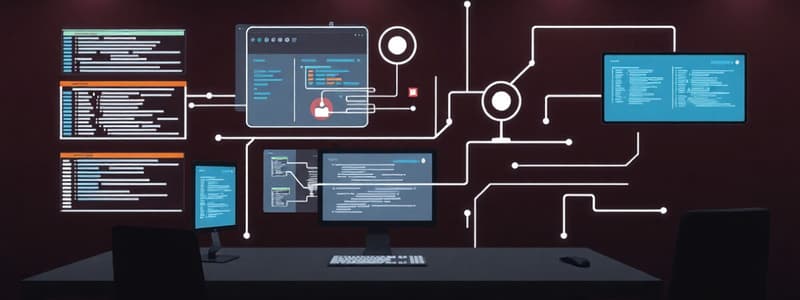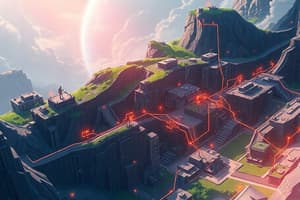Podcast
Questions and Answers
What is the first step in the system testing process?
What is the first step in the system testing process?
- Unit testing
- User acceptance testing
- System functional testing (correct)
- Integration testing
Which type of testing involves engaging store managers and warehouse staff for feedback?
Which type of testing involves engaging store managers and warehouse staff for feedback?
- Integration testing
- System functional testing
- User acceptance testing (correct)
- Unit testing
Which is NOT a method of gathering detailed information in the systems analysis activities?
Which is NOT a method of gathering detailed information in the systems analysis activities?
- Observing business processes
- Interviews
- Questionnaires
- Market research (correct)
What is one key benefit of Agile development?
What is one key benefit of Agile development?
In the requirements prioritization phase, what does the category 'Nice-to-Have' indicate?
In the requirements prioritization phase, what does the category 'Nice-to-Have' indicate?
What does unit testing involve?
What does unit testing involve?
Which of the following is NOT an example of a non-functional requirement?
Which of the following is NOT an example of a non-functional requirement?
What is the focus of developing user-interface dialogs?
What is the focus of developing user-interface dialogs?
What is the primary focus of systems design?
What is the primary focus of systems design?
Which activity is NOT part of the System Development Life Cycle (SDLC)?
Which activity is NOT part of the System Development Life Cycle (SDLC)?
During which stage of the software development process is the solution confirmed to meet the need?
During which stage of the software development process is the solution confirmed to meet the need?
What is included in the detailed design of components for an inventory management module?
What is included in the detailed design of components for an inventory management module?
What aspect of systems design involves creating user screen mockups?
What aspect of systems design involves creating user screen mockups?
Which step is crucial for planning and monitoring a project in SDLC?
Which step is crucial for planning and monitoring a project in SDLC?
What methodology is most commonly used in today's system development processes?
What methodology is most commonly used in today's system development processes?
What does the term 'Project' refer to in the context of information systems?
What does the term 'Project' refer to in the context of information systems?
What is one reason for modeling in system design?
What is one reason for modeling in system design?
Which technique is used to identify use cases from user goals?
Which technique is used to identify use cases from user goals?
How should use cases be named according to the given convention?
How should use cases be named according to the given convention?
What is an example of a step in the User Goal Technique?
What is an example of a step in the User Goal Technique?
What should be done after creating preliminary use cases?
What should be done after creating preliminary use cases?
What does the event decomposition technique help with?
What does the event decomposition technique help with?
Why is it important to communicate with users and stakeholders?
Why is it important to communicate with users and stakeholders?
What is a decomposed use case?
What is a decomposed use case?
What is an example of a use case for temporal events?
What is an example of a use case for temporal events?
Which of the following events is an example of a state event?
Which of the following events is an example of a state event?
What principle should be applied to focus analysis on event-related functions?
What principle should be applied to focus analysis on event-related functions?
Which of the following is NOT emphasized in the analysis of event-driven technology?
Which of the following is NOT emphasized in the analysis of event-driven technology?
What does a Generalization relation illustrate in use case modeling?
What does a Generalization relation illustrate in use case modeling?
In the context of an event-driven approach, what does 'Right-Level Decomposition' refer to?
In the context of an event-driven approach, what does 'Right-Level Decomposition' refer to?
What action should NOT be included in the initial analysis of event-driven technology?
What action should NOT be included in the initial analysis of event-driven technology?
Which of the following captures both temporal and state events in a broader sense?
Which of the following captures both temporal and state events in a broader sense?
What is the purpose of a Use Case Diagram in UML?
What is the purpose of a Use Case Diagram in UML?
What differentiates Primary Actors from other actors in a use case context?
What differentiates Primary Actors from other actors in a use case context?
What does the System Boundary in a Use Case Diagram signify?
What does the System Boundary in a Use Case Diagram signify?
In the context of the Event Decomposition Technique, what type of event is triggered by an action or request from outside the system?
In the context of the Event Decomposition Technique, what type of event is triggered by an action or request from outside the system?
How would a Temporal Event be characterized in the Event Decomposition Technique?
How would a Temporal Event be characterized in the Event Decomposition Technique?
What does the Automation Boundary illustrate in a system design?
What does the Automation Boundary illustrate in a system design?
What is a key step in applying the Event Decomposition Technique?
What is a key step in applying the Event Decomposition Technique?
What is not a type of Use Case in the Event Decomposition Technique?
What is not a type of Use Case in the Event Decomposition Technique?
Flashcards are hidden until you start studying
Study Notes
Systems Design Activities
- Defining the system architecture: The architect decides on the technical architecture for the system. For example, they might choose to build a web application with a cloud-based database.
- Detailed design of components: Every part of the system is designed in detail, including forms, tables, and automatic alerts.
- Designing the database: A database is created to store all of the relevant data. The database design will include tables, table relationships, and rules for data entry.
- User Interface (UI) design: The designer creates mockups of how the screens will look for the user to make sure that the system is intuitive and easy to use.
The Software Development Process
- Understand the need: This is where developers identify the business need for the system.
- Capture the vision: The vision for the system is developed.
- Define a solution: A solution is developed to directly address the need.
- Communicate the vision and solution: The vision and solution are communicated with the stakeholders.
- Build the solution: Developers build the solution based on the design.
- Confirm that the solution meets the need: The system is tested to make sure that it meets the needs.
- Launch the solution system: The system is made available to the users.
The System Development Life Cycle (SDLC)
- The SDLC is the complete process for building, launching, and maintaining an information system.
- It includes six core processes:
- Identify the problem or need and obtain approval.
- Plan and monitor the project.
- Discover and understand the details of the problem or need.
- Design the system components that solve the problem.
- Build, test, and integrate system components.
- Complete system tests and then deploy the solution.
- Project: A project is a planned undertaking with a defined beginning and end that is intended to produce a specific result.
System Development Process
- System Development Process is the actual approach used to develop a particular information system.
- Most development processes now use Agile and Iterative development.
- Agile Development: Uses small, functional increments to deliver the system. This allows for flexibility and frequent feedback.
System Analysis Activities
- Gather Detailed Information: This involves the use of several techniques including interviews, questionnaires, reviewing documents, observing business processes, research, and collecting comments.
- Define Requirements: Developers model the system's functional requirements and define non-functional requirements.
- Prioritize Requirements: Requirements are categorized according to their importance: Essential, important, and nice-to-have.
- Develop User-Interface Dialogs: The flow of interaction between the user and the system is designed.
- Evaluate Requirements with Users: Engage with users to get feedback and adapt requirements.
Information Gathering Techniques
- Several techniques can be used to gather information about a system.
- Interviews
- Questionnaires
- Reviewing documents
- Observing business processes
- Researching vendors
- Collecting comments and suggestions
Reasons for Modeling
- Learning from the Modeling Process: Models can be used to gain insights and understanding.
- Reducing Complexity by Abstraction: Models can simplify complex systems.
- Remembering All the Details: Models can help to ensure that all aspects of the system are documented.
- Communicating with Development Team Members: Models help to facilitate clear communication and collaboration.
- Communicating with Users and Stakeholders: Models can be used to ensure that users and stakeholders understand the system.
- Documenting for Future Maintenance/Enhancement: Models provide a useful reference for future updates and maintenance.
Use Cases
- Definition: A use case is an activity that the system performs, often in response to a request from a user.
- Purpose: Use cases are used to define the functional requirements for a system.
- Decomposition: Analysts break down the system into a set of smaller use cases.
- Techniques for Identifying Use Cases:
- User Goal Technique
- Event Decomposition Technique
- Naming Convention: Use cases are named using a verb-noun format.
User Goal Technique Steps
- Identify Potential Users: The first step is to identify all users.
- Classify Users by Functional Role: Users are grouped according to the roles they play in the system.
- Classify Users by Organizational Level: Users are further categorized based on their organizational level.
- Interview Users: Each type of user is interviewed to gather information on their goals for the system.
- Create Preliminary Use Cases: A preliminary list of use cases is created.
- Resolve Duplicates and Inconsistencies: Resolve any issues with the use case names.
- Identify Shared Use Cases: Determine which use cases are shared between different users.
- Review with Users and Stakeholders: The list of use cases is reviewed with users and stakeholders.
Use Case Diagrams
- Definition: A Use Case Diagram is used to visually represent use cases and how they relate to actors.
- Unified Modeling Language (UML): UML is a standardized modeling language used for designing information systems.
- Actor: An actor represents an end user or another system that interacts with the system.
- Primary Actors: Primary actors initiate the use cases, interacting with the system directly to achieve goals.
- System Boundary: This indicates the limits of the application, highlighting what is part of the system versus what is external to it.
- Automation Boundary: The Automation Boundary shows the separation between computerized parts of the system and the user interactions.
Event Decomposition Technique (EDT)
- Identify Events:
- External Events: Occurs outside the system, initiated by an external actor.
- Temporal Events: Triggered by reaching a specific time.
- State Events: Triggered by changes within the system or its internal state.
- Naming Use Cases: Each event is assigned a corresponding use case that describes the response of the system to that event.
Benefits of EDT
- Broader Event Capture: Includes temporal and state events, not just user goals.
- Right-Level Decomposition: Helps break down processes into EBPs, which are basic, single-person tasks done in response to an event.
- Perfect Technology Assumption: Focuses on core functions rather than system controls or error handling.
Temporal Events (Examples)
- Automatically finalize class lists on a specific date to prevent further enrollment.
- Automatically generate a monthly report.
State Events (Examples)
- When a course section is full and the waitlist reaches 20 students, automatically create a new course section.
- When the inventory level falls below the reorder point, automatically reorder inventory.
Modified Use Case Model (Example)
- Student:
- Display Scheduled Course Sections
- Enroll in Course Section
- Waitlist for Course Section
- Display Timetable
- Drop Course Section
- Cancel Waitlist
- System:
- Finalize Class Lists
- Open New Course Section
Generalization – Use Case
- A Generalization relation is used to indicate that a specialized use case is a specific way to achieve the goals described by a general use case.
- The open arrowhead points at the more general use case.
Generalization - Actors
- A Generalization link can also be drawn between actors, to indicate a specialization relationship.
Studying That Suits You
Use AI to generate personalized quizzes and flashcards to suit your learning preferences.



